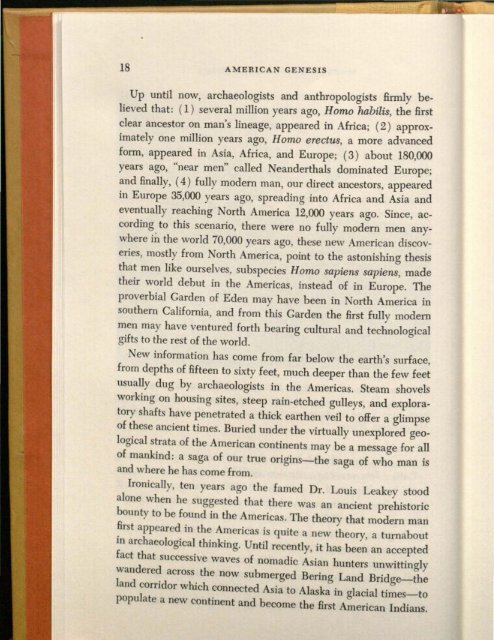You also want an ePaper? Increase the reach of your titles
YUMPU automatically turns print PDFs into web optimized ePapers that Google loves.
18 AMERICAN GENESIS<br />
Up until now, archaeologists <strong>and</strong> anthropologists firmly believed<br />
that: (1) several million years ago, Homo habilis, <strong>the</strong> first<br />
clear ancestor on man's lineage, appeared in Africa; (2) approximately<br />
one million years ago, Homo erectus, a more advanced<br />
form , appeared in Asia, Africa, <strong>and</strong> Europe; (3) about 180,000<br />
years ago, "near men" called Ne<strong>and</strong>erthals dominated Europe;<br />
<strong>and</strong> finally, ( 4) fully modern man, our direct ancestors, appeared<br />
in Europe 35,000 years ago, spreading into Africa <strong>and</strong> Asia <strong>and</strong><br />
eventually reaching North America 12,000 years ago. Since, according<br />
to this scenario, <strong>the</strong>re were no fully modern men anywhere<br />
in <strong>the</strong> world 70,000 years ago, <strong>the</strong>se new <strong>American</strong> discoveries,<br />
mostly from North America, point to <strong>the</strong> astonishing <strong>the</strong>sis<br />
that men like ourselves, subspecies Homo sapiens sapiens, made<br />
<strong>the</strong>ir world debut in <strong>the</strong> Americas, instead <strong>of</strong> in Europe. <strong>The</strong><br />
proverbial Garden <strong>of</strong> Eden may have been in North America in<br />
sou<strong>the</strong>rn California, <strong>and</strong> from this Garden <strong>the</strong> first fully modem<br />
men may have ventured forth bearing cultural <strong>and</strong> technological<br />
gifts to <strong>the</strong> rest <strong>of</strong> <strong>the</strong> world.<br />
New information has come from far below <strong>the</strong> earth's surface,<br />
from depths <strong>of</strong> fifteen to sixty feet, much deeper than <strong>the</strong> few feet<br />
usually dug by archaeologists in <strong>the</strong> Americas. Steam shovels<br />
working on hOusing sites, steep rain-etched gulleys, <strong>and</strong> exploratory<br />
shafts have penetrated a thick ear<strong>the</strong>n veil to <strong>of</strong>fer a glimpse<br />
<strong>of</strong> <strong>the</strong>se ancient times. Buried under <strong>the</strong> virtually unexplored geological<br />
strata <strong>of</strong> <strong>the</strong> <strong>American</strong> continents may be a message for all<br />
<strong>of</strong> mankind: a saga <strong>of</strong> Our true origins-<strong>the</strong> saga <strong>of</strong> who man is<br />
<strong>and</strong> where he has come from.<br />
Ironically, ten years ago <strong>the</strong> famed Dr. Louis Leakey stood<br />
alone when he suggested that <strong>the</strong>re was an ancient prehistoric<br />
bounty to be found in <strong>the</strong> Americas. <strong>The</strong> <strong>the</strong>ory that modem man<br />
first appeared in <strong>the</strong> Americas is quite a new <strong>the</strong>ory, a turnabout<br />
in archaeological thinking. Until recently, it has been an accepted<br />
fact that successive waves <strong>of</strong> nomadic Asian hunters unwittingly<br />
w<strong>and</strong>ered across <strong>the</strong> now submerged Bering L<strong>and</strong> Bridge-<strong>the</strong><br />
l<strong>and</strong> corridor which connected Asia to Alaska in glacial times-to<br />
populate a new continent <strong>and</strong> become <strong>the</strong> first <strong>American</strong> <strong>Indian</strong>s.


















